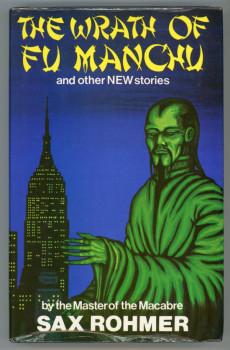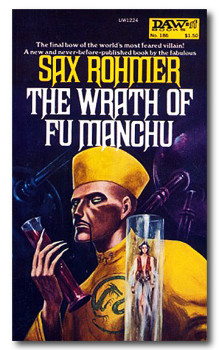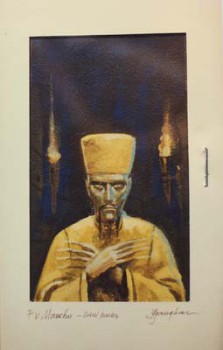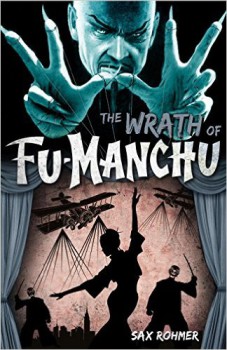Blogging Sax Rohmer’s The Wrath of Fu Manchu, Part Two

 When Rohmer scholar, Dr. Robert E. Briney compiled a posthumous hardcover collection of the author’s rare and previously uncollected short fiction in the early 1970s, he included three short stories that were first published in This Week magazine in between Rohmer’s last two Fu Manchu novels. The stories were subsequently reprinted in sequence in Edgar Wallace Mystery Magazine between January and March 1966 where the latter two stories were retitled. The hardcover collection, The Wrath of Fu Manchu and Other New Stories was first published in the U.K. in 1973 by Tom Stacey. A U.S. mass market paperback edition from DAW Books followed in 1976. The collection was subsequently reprinted in 2001 as part of Allison & Busby’s Fu Manchu Omnibus – Volume 5. Titan Books will reprint the original collection as a trade paperback in March 2016.
When Rohmer scholar, Dr. Robert E. Briney compiled a posthumous hardcover collection of the author’s rare and previously uncollected short fiction in the early 1970s, he included three short stories that were first published in This Week magazine in between Rohmer’s last two Fu Manchu novels. The stories were subsequently reprinted in sequence in Edgar Wallace Mystery Magazine between January and March 1966 where the latter two stories were retitled. The hardcover collection, The Wrath of Fu Manchu and Other New Stories was first published in the U.K. in 1973 by Tom Stacey. A U.S. mass market paperback edition from DAW Books followed in 1976. The collection was subsequently reprinted in 2001 as part of Allison & Busby’s Fu Manchu Omnibus – Volume 5. Titan Books will reprint the original collection as a trade paperback in March 2016.
“The Eyes of Fu Manchu” was serialized in two installments in This Week magazine on October 6 and 13, 1957. It first appeared in book form when Dr. Briney added it to the 1970 Ace paperback collection, The Secret of Holm Peel and Other Strange Stories. The story opens with Sir Denis Nayland Smith attending a lecture at the Sorbonne by an American scientist, Dr. Gregory Allen. Dr. Allen is a specialist in the possible chemical means of halting or even reversing the effects of aging. Sir Denis correctly believes Dr. Allen’s research will draw him to the attention of Dr. Fu Manchu. He makes plans to attend Dr. Allen’s upcoming lecture at King’s College in London with Dr. Petrie who is flying in from Cairo.
Rohmer mines one of his own life’s episodes when he encountered and began an extramarital affair with a young bohemian woman while on a voyage to Madeira. Here, Gregory Allen meets a young bohemian woman named Mignon while crossing the English Channel. Mignon is an artist and, upon learning Gregory abandoned his study of art for science, she makes some pointed remarks about his abandoning the bohemian life of freedom and truth for one of compromised values as part of the Establishment. Her words seem to sting Dr. Allen as much as her beauty and youth charm him just as Rohmer, the former bohemian turned established bestselling author and husband must have felt when he began his own affair with a younger free spirit on his voyage to Portugal years before.
Gregory pursues Mignon while in London and once he has her in his hotel room, he shares the sketch he made of her (his first piece of art in many years). However, before he can get anywhere with her, she drugs his drink and he winds up a victim of Fu Manchu’s induced catalepsy. The Devil Doctor turns up in his apartment. Before he can successfully arrange to spirit his paralyzed victim away, Sir Denis and Dr. Petrie arrive and inadvertently scare Fu Manchu off, saving Gregory in the process. Smith warns Gregory that Mignon is an agent of the Si-Fan and makes Gregory swear never to see her again. Of course, he cannot keep that vow and succeeds in arranging a meeting with her at an art gallery.
The assignation takes place and Mignon reveals that her father (a scientist specializing in rare insects) is a captive of the Si-Fan which binds her to serving the organization against her will. Gregory follows her and falls into the hands of one of Fu Manchu’s minions. He awakens and learns Fu Manchu has added him to the collection of scientific minds he is “recruiting” for the Si-Fan. Happily, Sir Denis had Gregory followed and a hasty police raid on Fu Manchu’s newly-discovered headquarters results in Gregory, Mignon, and her father being liberated while Fu Manchu makes good his escape. The story ends on a happy note of sorts with Mignon free to love Gregory and thrilled her father is safe at last. The conflict between a life among the establishment and one of bohemian freedom that drove Rohmer to tell the tale is never addressed in the sentimental and conventional conclusion.

 “The Word of Fu Manchu” was a short story originally published as “The Night Fu Manchu Learned Fear” in the March 9, 1958 issue of This Week magazine. This minor episode sees Sir Denis still in London bringing along his friend, Fleet Street journalist Malcolm Forbes (this namesake of the real life millionaire is an obvious retread of Fleet Street journalist Bart Kerrigan from 1939’s The Drums of Fu Manchu and 1941’s The Island of Fu Manchu). Together they arrive at the apartment of a Scotland Yard man who has successfully infiltrated the Si-Fan. The situation is an overly familiar one. The detective is dead. There is a beautiful foreign girl in his apartment (Nadia Rostov) who is an agent of the Si-Fan that led the poor man to his death.
“The Word of Fu Manchu” was a short story originally published as “The Night Fu Manchu Learned Fear” in the March 9, 1958 issue of This Week magazine. This minor episode sees Sir Denis still in London bringing along his friend, Fleet Street journalist Malcolm Forbes (this namesake of the real life millionaire is an obvious retread of Fleet Street journalist Bart Kerrigan from 1939’s The Drums of Fu Manchu and 1941’s The Island of Fu Manchu). Together they arrive at the apartment of a Scotland Yard man who has successfully infiltrated the Si-Fan. The situation is an overly familiar one. The detective is dead. There is a beautiful foreign girl in his apartment (Nadia Rostov) who is an agent of the Si-Fan that led the poor man to his death.
Nadia has been sent to retrieve a metal disc that the detective is wearing around his neck. While Forbes is smitten with Nadia, she does not respond to him in a surprising diversion from the established formula. Nadia remains a rare Rohmer femme fatale who does not defect for love. While page count may have been the principal consideration, it is also possible that the virulently anti-communist Rohmer may have viewed a Russian femme fatale as unsympathetic and unworthy of redemption.
The scene shifts to Sir Denis’ apartment. He has a new valet, Begby who has inexplicably replaced Fey. While discussing the mysterious metal disc, Dr. Fu Manchu arrives alone at Sir Denis’ door and requests the return of the metal disc. He explains it is an identification disc for Si-Fan agents that doubles as a means of electrocution (the mysterious cause of death for the Scotland Yard detective is now explained). Fu Manchu makes a deal to spare Forbes’ life (as the journalist is now holding the disc) if Sir Denis will allow Fu Manchu to leave freely with his property. Knowing Fu Manchu always keeps his word, Sir Denis agrees thereby saving his friend’s life in the hasty resolution to this all too brief episode.
“The Mind of Fu Manchu” was a short story first published as “Fu Manchu and the Frightened Redhead” in the February 1, 1959 issue of This Week magazine. Rohmer submitted the story under the title, “The Secret of the Flying Saucer.” This very rushed story reworks elements from Rohmer’s unproduced stage play and later novel, The Shadow of Fu Manchu (1948). The story concerns Dr. Bruce Garfield, a scientist working on perfecting anti-gravity jet propulsion for the U.S. government. He is in London for a lecture when Fu Manchu abducts his girlfriend, Pat Merton. Hypnotized by the Devil Doctor, she leads the Si-Fan to where Bruce’s prototype flying saucer is stored. Always a man of his word, Fu Manchu returns Pat to the hotel where she and Bruce are staying while in London.
Sir Denis has hastily returned from Hong Kong (on undisclosed business not involving Fu Manchu) upon learning Dr. Garfield is in London. Smith is of course aware Fu Manchu has been abducting scientists there in recent months to press them into the Si-Fan’s service. Sir Denis, Dr. Garfield, and a raiding party from Scotland Yard are led by the dazed girl to Fu Manchu’s new base of operations. There they recover the prototype saucer but learn the base has been abandoned. Fu Manchu speaks to them via radio transmitter and dismisses Garfield’s prototype as crude and unworthy of his attention. The surprise ending is Bruce’s revelation that Fu Manchu only examined his very first prototype and the more advanced models produced by the US government are responsible for the UFO sightings that have made headlines around the world.
These three stories form a unique narrative of Fu Manchu’s London operations in the 1950s. The aging Sir Denis and the reference to Hong Kong appear to be influenced by the short-lived Adventures of Dr. Fu Manchu television series produced by Republic Pictures in 1956. The late period return of Dr. Petrie in the first story likewise suggests the influence of the character’s recent small screen incarnation. While minor efforts all around, it is interesting that Rohmer returned to the series’ episodic roots at the end of his life with these three minor stories that were written between his last two novels in the series.
William Patrick Maynard was licensed by the Sax Rohmer Literary Estate to continue the Fu Manchu thrillers beginning with The Terror of Fu Manchu (2009; Black Coat Press) and The Destiny of Fu Manchu (2012; Black Coat Press). The Triumph of Fu Manchu is coming soon from Black Coat Press.
Over the past few years I’ve become acquainted with Rohmer and his great creation by reading the first three novels. I found them absolutely enthralling. One thing, though – Fu is so superior to his opponents – more intelligent, more ruthless, more farsighted, subtler, all by several degrees of magnitude – that any victory over him seems utterly absurd. The only logical conclusion is that in his brilliance, Fu engineers his own (seeming) defeats to further his own deep ends, and that Petrie and Nayland-Smith are just puppets unknowingly being manipulated by the master, every step of the way. Has Anyone ever taken this tack in a Fu-Manchu story?
Rohmer seemed to suggest it was his unreliable minions that were behind Fu Manchu’s repeated setbacks. Generally, the Devil Doctor only retreated to avoid arrest, he rarely faced anything that looked like genuine defeat. That said, Nayland Smith frequently voices the fact that efforts against so colossal a genius render them as ineffective as children. Smith likewise has suggested Fu Manchu is a puppet master pulling the strings while his puppets are unable to comprehend his strategy. It’s all an essential part of the fevered paranoia such conspiracy fiction depends upon to maintain its pace and the reader’s willing suspension of disbelief.